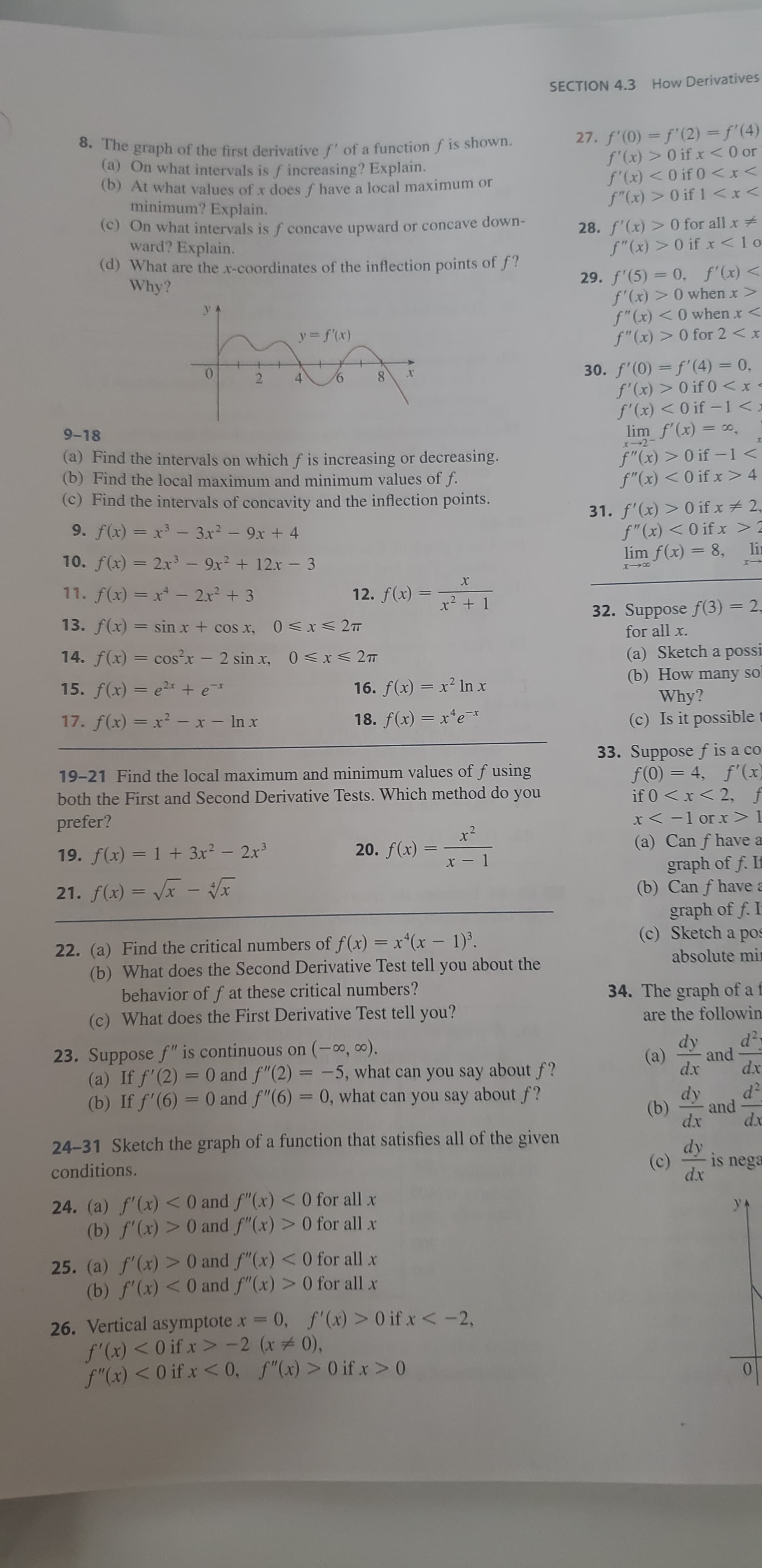How Derivatives SECTION 4.3 8. The graph of the first derivative f' of a function f is shown. (a) On what intervals is f increasing? Explain. (b) At what values of x does f have a local maximum or minimum? Explain. (c) On what intervals is f concave upward or concave down- ward? Explain. (d) What are the x-coordinates of the inflection points of f Why? 27. f'(0) f'(2) =f'(4) f'(x)> 0 if x< 0 or f'(x)<0 if 0 0 if 1 < x< 28. f'(x)> 0 for all x f"(x)> 0 if x< 1 o 29. f'(5) 0. f'(x) f'(x)> 0 when x > f" (x)< O when x f"(x)> 0 for 2 < x y= f(x) 30. f'(0)= f'(4) 0, f'(x)>O if 0 0 if -1 < f"(x) < 0 if x > 4 31. f'(x)> 0 if x 2, f"(x) < 0 if x > 2 lin 9. f(x) x3- 3x2-9x + 4 10. f(x) 2x3-9x2+12x - 3 lim f(x) 8, 1 11. f(x) x -2x2 +3 X 12. f(x) = x2 1 32. Suppose f(3) for all x. 2- 13. f(x)= sin x + cos x, 0 x< 2T 14. f(x) cosx 2 sin x, 0 x< 2T (a) Sketch a possi (b) How many so Why? (c) Is it possible 15. f(x)= e2x + e 16. f(x)= x2 In x 17. f(x) x - x- Inx 18. f(x) xte 33. Suppose f is a co f(0)= 4, f'(x) if 0 x< 2, f x <-1 or x> 1 (a) Can f have a graph of f. If (b) Can f have a graph of f. I (c) Sketch a pos absolute mi 19-21 Find the local maximum and minimum values off using both the First and Second Derivative Tests. Which method do you prefer? 20. f(x) 19. f(x) 1 +3x2- 2x3 21. f(x) /x 22. (a) Find the critical numbers of f(x) = x*(x - 1) (b) What does the Second Derivative Test tell you about the behavior of f at these critical numbers? (c) What does the First Derivative Test tell you? 34. The graph of a f are the followin 23. Suppose f" is continuous on (-co, oo), (a) If f'(2)= 0 and f"(2)= 5, what can you say about f? (b) If f'(6) 0 and f"(6) = 0, what can you say about f? d2 dy and dx (a) dx 1 d2 y and (b) dx dx 24-31 Sketch the graph of a function that satisfies all of the given conditions. is nega (c) dx 24. (a) f'(x)<0 and f"(x)<0 for all x (b) f'(x)> 0 and f"(x)> 0 for all x yA 25. (a) f'(x)> 0 and f"(x) < 0 for all x (b) f'(x)< 0 and f"(x)> 0 for allx f'(x)> O if x < -2, 26. Vertical asymptote x 0, f'(x)-2 (x 0), f "(x)< 0 if x< 0, f"(x)>0 if x > 0 0
Permutations and Combinations
If there are 5 dishes, they can be relished in any order at a time. In permutation, it should be in a particular order. In combination, the order does not matter. Take 3 letters a, b, and c. The possible ways of pairing any two letters are ab, bc, ac, ba, cb and ca. It is in a particular order. So, this can be called the permutation of a, b, and c. But if the order does not matter then ab is the same as ba. Similarly, bc is the same as cb and ac is the same as ca. Here the list has ab, bc, and ac alone. This can be called the combination of a, b, and c.
Counting Theory
The fundamental counting principle is a rule that is used to count the total number of possible outcomes in a given situation.
I need help with problem #15 in Section 4.3, page 301, in the James Stewart Calculus Eighth Edition textbook.

Trending now
This is a popular solution!
Step by step
Solved in 7 steps with 7 images




